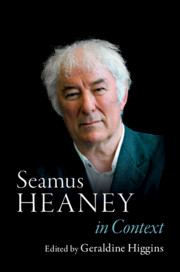Book contents
- Seamus Heaney in Context
- Seamus Heaney in Context
- Copyright page
- Dedication
- Contents
- Contributors
- Acknowledgements
- Abbreviations
- Introduction
- I Mapping
- II Influences and Traditions
- III Poetics
- Chapter 10 Lyric Form
- Chapter 11 Proper Nouns
- Chapter 12 Language
- Chapter 13 Elegy
- Chapter 14 Music
- IV Publishing
- V Frameworks
- VI Critical Contexts
- VII Legacy
- Index
Chapter 14 - Music
from III - Poetics
Published online by Cambridge University Press: 15 March 2021
- Seamus Heaney in Context
- Seamus Heaney in Context
- Copyright page
- Dedication
- Contents
- Contributors
- Acknowledgements
- Abbreviations
- Introduction
- I Mapping
- II Influences and Traditions
- III Poetics
- Chapter 10 Lyric Form
- Chapter 11 Proper Nouns
- Chapter 12 Language
- Chapter 13 Elegy
- Chapter 14 Music
- IV Publishing
- V Frameworks
- VI Critical Contexts
- VII Legacy
- Index
Summary
Music haunts Seamus Heaney’s poetry and criticism. The word music and its siblings – song, chorus, rhythm, note, etc. – appear throughout his work. Again and again, Heaney urges us to pay attention to words, to feel how they sound, to believe what we hear. The textbook distinction between sound and sense does little to elucidate Heaney’s poetry, where so often the sense is the sound, and vice versa: Gweebara, omphalos, rasp, nick, squelch. What gives music such force in Heaney’s work is its ability to coordinate a range of concerns. It troubles the primarily discursive function of language; it posits the body as an instrument of knowing; and it summons the powerful figure of Irish folk tradition. In short, music allows Heaney to reckon both with what it means to be a lyric poet, and what it means to be an Irish poet.
- Type
- Chapter
- Information
- Seamus Heaney in Context , pp. 157 - 164Publisher: Cambridge University PressPrint publication year: 2021

